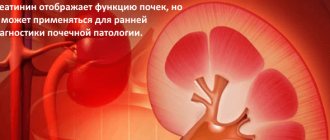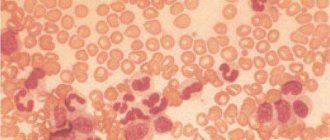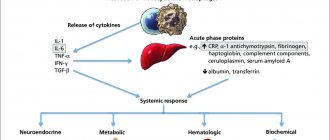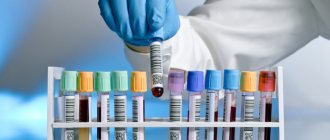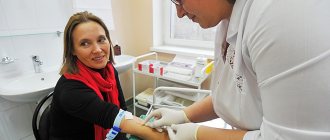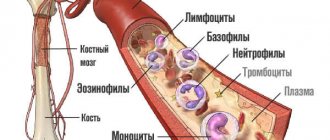Laboratory diagnostics plays an important role in medical practice. Without it, it is difficult to recognize various ailments. Among the wide variety of laboratory tests, determination of the level of ROE in the blood now plays a huge role. The meaning of this abbreviation is the erythrocyte sedimentation reaction. Otherwise, this indicator is defined as the erythrocyte sedimentation rate. This reaction is necessary to determine the inflammatory process. Blood is a biologically active liquid that can change quality indicators. This is due to the presence of certain ailments. In men, ROE differs from the same indicator in women due to the characteristics of the body.
The norms of the erythrocyte sedimentation reaction change with age. With pathologies, this indicator may increase or decrease. ROE is determined according to the standard scheme. The basis of the reaction is the ability of red blood cells to settle under the influence of their own gravity. The conditions must be such that the blood is liquid and does not clot. The red blood cells slowly sink to the bottom of the tube. This indicator can increase their aggregation (sticking together). At the same time, the mass of red blood cells increases, but the resistance decreases.
What is ROE and its significance for the body
What is RO ESR (ESR)—erythrocyte sedimentation rate. The analysis is one of the main basic blood tests. A referral for examination is issued upon initial consultation with a doctor, before medical procedures or surgical interventions.
Laboratory essence of the method: healthy red blood cells precipitate slowly. Aggregated (glued) red blood cells have a greater mass and settle at a faster rate. Factors that indicate the activation of the immune response to pathology in the body lead to the sticking of red blood cells.
The erythrocyte sedimentation reaction is a nonspecific laboratory indicator that indirectly indicates pathological disorders in the body. Based on ROE, a final diagnosis cannot be made, but the direction of further research can be determined.
Reasons for low ESR
A low relative to normal erythrocyte sedimentation rate is quite rare. In most cases, this situation is provoked by disorders of hyperhydration (water-salt metabolism) in the body. In addition, low ESR may be a consequence of developing muscle dystrophy and liver failure. Among the non-pathological causes of low ESR are the use of corticosteroids, smoking, vegetarianism, prolonged fasting and early pregnancy, but there is practically no systematicity in these prerequisites. Finally, let’s summarize all the information about ESR:
- this is a non-specific indicator. It is impossible to diagnose the disease using it alone;
- An increase in ESR is not a reason for panic, but it is a reason for in-depth analysis. The reasons can be both very harmless and quite serious;
- ESR is one of the few laboratory tests that is based on a mechanical action rather than a chemical reaction;
- Automatic systems for measuring ESR that were not available until recently made laboratory technician error the most common cause of a false erythrocyte sedimentation rate test result.
The table is normal
The analysis is deciphered taking into account norms that are different for each age. The high variability of norms in women is associated with changes in hormonal levels during different periods of life.
Standards for children:
| Child's age | Floor | ESR norm mm/hour |
| 0-1 month | m/f | 2-3 |
| 1-12 months | m/f | 2-8 |
| 1-5 years | m/f | 4-12 |
| 5-10 years | m/f | 4-12 |
| teenagers | M F | 1-10 2-15 |
For men, the ROE indicator is in the range of 2-15 mm/hour.
In women, ESR has its own characteristics:
- indicators are on average higher than those of men;
- in the morning the indicator increases;
- large variation in the indicator at different periods of life;
- severe pathology is indicated only by long-term and significant deviations of ESR from the norm.
The ROE norm in the blood of women by age is studied in flasks like these. Table below
ROE (the norm for women by age), a table with the value of which shows their change, can range from 2 to 45 mm/hour.
| Age | ESR norm mm/hour |
| Children under 13 years old | 4-12 |
| Teenagers 14-17 years old | 3-18 |
| Young women 18-30 years old | 2-15 |
| Middle-aged women 31-40 years old | 2-20 |
| Middle-aged and perimenopausal women 41-50 years old | 2-30 |
| Women 51-60 years old, menopause, menopause, postmenopause | 2-30 |
| Women over 60 years old | 2-40 |
| pregnant women | 2-45 |
As can be seen from the table, the ROE norm can differ significantly at different age and physiological periods of a woman. The ESR indicator indicates physiological and pathological abnormalities in the body.
Factors influencing the ESR value in a child
ESR is a sensitive indicator that changes under the influence of many factors, both pathological and physiological. If a child has suffered from acute respiratory viral infection, his ESR value will be increased within 4-6 weeks after recovery. The following factors also influence the ESR value:
- increased physical activity;
- stressful situations;
- unbalanced diet;
- helminths;
- deficiency of vitamins and microelements;
- decrease or increase in the number of red blood cells;
- changes in blood viscosity or acidity;
- Times of Day;
- age (in children under one year of age, indicators are very different from normal for adults or adolescents);
- floor.
Test results are influenced by many factors, so doctors sometimes ask patients for a second blood donation.
Symptoms of an increased rate
Symptoms indicating increased ROE:
- inflammatory processes accompanied by pain;
- dental pain;
- acute pain in the abdomen;
- heartache;
- pain in the joints and spine.
With a low ESR, the following conditions are observed:
- dizziness;
- nausea;
- weakness;
- yellowing of the skin and whites of the eyes.
A reduced ROE in the body can also be a signal of dangerous pathologies.
ROE indicators for pregnant women
The rate of sedimentation directly depends on the number of years, changes that occur according to age characteristics and physiological changes. Pregnancy is the cause of ROE deviation from the norm. Hormonal changes, a new life developing inside a woman leads to disturbances. In order for the unborn child to absorb nutrients through the umbilical cord entering the mother’s body, the viscosity of the blood changes. Accordingly, the analyzes will show results that will differ from the figures for young girls.
ROE table according to gestational age
| Term | mm/hour |
| From 1 to 20 weeks | 45-60 |
| From 20 to 40 weeks | 60-70 |
The data in the table indicates an uneventful pregnancy. The indicators will be different if the woman feels unwell. You should pay attention to the following symptoms:
- increased body temperature;
- fatigue, vertigo;
- constant nausea, loss of appetite and weight;
- frequent headache;
- pain in muscles and joints.
Changes in the body can occur over a period of nine months. This requires constant monitoring by a doctor.
Reasons for the increase
The ESR indicator can be increased as a result of physiological processes and pathological changes in the body.
ROE (normal blood levels in women by age), a table with the value of which shows their changes, can reach 45 mm/hour. Thus, during puberty in adolescents, ROE can normally reach up to 19 mm/hour, during pregnancy up to 45 mm/hour, during menopause and menopause up to 30 mm/hour, in women with impaired ovarian function up to 40 mm/hour.
Physiological reasons for an increase in ROE are also allergic reactions, various diets, and fasting.
A pathological increase in ROE occurs in many diseases:
- Inflammatory diseases of various etiologies. Joint pathologies—arthritis, arthrosis, rheumatism, inflammatory-degenerative diseases of the spine.
- Viremia of various origins. Flu, ARVI, herpes diseases.
- Bacterial infections and their complications. Tuberculosis, tonsillitis, bronchitis, pneumonia.
- Endocrine and autoimmune diseases. Diabetes mellitus, systemic lupus erythematosus, thyrotoxicosis.
- Ulcers, abscesses, sepsis.
- Inflammatory diseases of the female genital area. Endometriosis, ovarian cysts, inflammation of the appendages and fallopian tubes.
- Hematopoietic disorders.
- Exacerbations of chronic diseases—pancreatitis, cholecystitis, stomach ulcers.
- Long periods of high ROE may be a sign of the onset of an oncological process.
Reasons for increased ROE
Increased levels of plasma proteins, cholesterol (), and the ability of blood cells to aggregate are associated with the following pathologies:
- Chronic or acute inflammation of an infectious nature. ESR allows you to find out what stage the disease is at and whether its treatment is effective. With a viral infection of the body, the index has lower parameters compared to bacterial infections.
- Impact of certain medications.
- Hypercholesterolemia.
- Severe poisoning of the body, especially with heavy metals.
- Injury to organs as a result of injury or surgery.
- Disturbances in the functioning of the endocrine glands, increased thyroxine and triiodothyronine (thyroid hormones).
- Damage to the liver, kidneys, intestines, pancreas.
- Heart diseases.
- Rheumatoid arthritis.
An ESR level of up to 70 mm/hour without inflammation may indicate an oncological process. This erythrocyte sedimentation reaction can be observed in various neoplasms, such as lymphosarcoma, myeloma and others.
Indications for research
A referral for ESR analysis is most often prescribed by a general practitioner. The analysis is carried out after acute viral and bacterial diseases to exclude the presence of complications.
Subspecialists can prescribe a referral for analysis:
- rheumatologist for joint pain; temperature, increased fatigue;
- surgeon for abscesses, suppuration, abdominal pain;
- nephrologist for problems with the urinary system;
- gynecologist for pain, pathological discharge;
- gastroenterologist for pain in the abdominal cavity, heaviness in the right hypochondrium, yellowing of the skin;
- endocrinologist for specific symptoms indicating metabolic disorders in the body;
- hematologist for a comprehensive examination of the hematopoietic process.
A referral for ESR testing is issued during planned hospitalization and surgical interventions. ESR is part of express tests during emergency operations.
ROE values in oncology
If, over a long period, ROE indicators do not correspond to the norm, you should pay attention to this. The cause may be serious health problems. Elevated values indicate a latent course of cancer. A decrease in sedimentation rate indicates that the number of red cells in the blood increases. In turn, this triggers the oncological process in the blood, as well as an increase in leukocytes, which leads to leukocytosis.
Attention! Neither a decrease nor an increase in the rate of red blood cells is felt by a person. You need to focus either on laboratory indicators or other symptoms.
In oncological diseases, ROE can increase to 70 mm/h. The norm will depend on the stage of the disease and the presence of metastasis. Against this background, hemoglobin decreases and other indicators of the health of the female body deteriorate. Neither antibacterial nor antiviral therapy can change the results.
How is the indicator determined?
The ROE indicator is determined using two methods.
Method according to Panchenkov. Blood from the ring finger is examined. The material is transferred to glass and an anticoagulant is added. The resulting laboratory solution is placed in a Panchenkov capillary with 100 divisions.
The erythrocyte sediment deposited within 60 minutes is assessed. The scale readings will be an indicator of the ROE value in mm/hour.
Westergen method . It is used more often; at high ROE levels it is more sensitive. Venous blood is collected for analysis.
The anticoagulant is mixed with the test material in a ratio of 1:4 and placed in a Westergen tube with a graduated scale of 200 mm. The number of red blood cells deposited as sediment is measured in mm/hour.
In the absence of disease, red blood cells precipitate singly, having a negatively charged potential that pushes them away from each other.
Inflammatory and other pathological processes lead to an increase in acute phase proteins in the blood plasma: immunoglobulin, fibrinogen, C-reactive protein. The presence of proteins leads to platelet sticking (aggregation), which causes acceleration of their precipitation.
The erythrocyte sedimentation rate is influenced by the presence of antibodies and lipids in the blood plasma. Plasma can have different oxidation states and ionic charges. The ROE values are affected by the number and shape of red blood cells and blood viscosity.
Decrease in ESR
A drop in ROE levels may be a sign of:
- heart pathologies;
- chronic lack of blood supply;
- dehydration;
- viral hepatitis or cirrhosis of the liver ();
- erythrocytosis - a reactive increase in the number of red blood cells;
- changes in hemoglobin structure ();
- sickle cell anemia, in which red blood cells are shaped like a sickle rather than biconcave discs, which reduces their sedimentation rate;
- high levels of albumin in the blood plasma, increasing its viscosity.
See also: Symptoms and treatment of cystitis in women
A decrease in ESR is also observed with vomiting and diarrhea.
ROE changes differently at different stages of even one pathology:
- With tuberculosis, ROE may remain unchanged, except in advanced cases or until the disease is accompanied by a complication.
- The acute period of an infectious disease is accompanied by an increased ESR only from 2-3 days. At the same time, with a diagnosis of lobar pneumonia, the indicator remains high, even if the crisis has passed.
- At the beginning of acute appendicitis (), the laboratory test values remain unchanged.
- A slight increase in ROE is observed with active rheumatism, but its decrease may indicate acidosis or blood thickening.
- The subsiding infectious process is accompanied by normalization of the total number of leukocytes, ROE decreases later.
Preparing for analysis
The ESR indicator is part of the general clinical blood test, but sometimes it is determined separately. Blood is taken from a vein or from a finger, depending on the method used by the laboratory to evaluate the value of the indicator.
To ensure that the test does not show a false positive or false negative result, you need to prepare for the test for several days.
For an accurate measurement:
- take the test before 10 am, strictly on an empty stomach; as an exception, it is permissible to drink a small amount of liquid;
- 2-3 days before the examination, avoid spicy, salty, smoked foods;
- follow a diet, eat boiled or steamed foods;
- Do not drink alcohol or smoke for several hours before the test;
- before the examination, reduce the intensity of physical activity and training;
- Discuss taking medications and performing medical procedures with your doctor.
The results of the analysis may be affected by:
- cyclical changes, hormonal fluctuations in the female body (pregnancy, menopause, menstruation, ovulation);
- stress, psycho-emotional stress;
- other studies and physical procedures performed previously.
When testing blood from a finger, a scarifier, sterile needle or lancet is used. Modern machines for drawing blood from a finger contain a lancet enclosed in a plastic case with a puncture depth regulator. The upper phalanx of the ring finger is wiped with a cotton swab moistened with an antiseptic. After this, blood is drawn.
Only a person qualified as a nurse, paramedic or doctor can take venous blood for analysis. Most often, the median ulnar vein or external superficial vein is used. In some people it is difficult to find a vein. In such cases, blood is drawn from the back of the hand.
A tourniquet is applied to the forearm, and the bend of the elbow is treated with an antiseptic. The needle is inserted at an angle of 45°. After blood is drawn, the arm is bent at the elbow to prevent bruising. The period for performing analysis by any method does not exceed one day.
Conducting research
First, let's figure out what ROE is. Red blood cells, as formed elements of blood, have a certain mass and settle over time, but not always with the same acceleration. The speed depends on the red blood cells themselves and the composition of the plasma. If the immune system is active, the plasma becomes thicker due to additional protein fractions. The latter slow down the process of sedimentation of red blood cells, which affects ROS (erythrocyte sedimentation reaction).
The study is carried out in the morning on an empty stomach. The day before it is necessary to avoid spicy, fried and fatty foods. Before the procedure, you can drink only water, do not drink alcohol, smoke, or be nervous so that the initial data does not change.
The study begins with taking blood from a finger into capillaries with an anticoagulant, which are left in a vertical position in a Panchenkov stand. Within 1 hour, the blood is divided into layers. A column of plasma appears above the layer of settled red blood cells. Its height in mm/hour represents ROE in a blood test.
There is also a more accurate modern automated modification of the Westergren test, in which results are obtained in 30 minutes, but it is rarely used.
Decoding the analysis results
If the test result shows an increased level of ROE, there is no need to immediately panic.
It must be remembered that many factors can influence the increase in the indicator:
- physical and emotional stress;
- taking certain medications—salicylates, hormonal contraceptives;
- recent vaccination;
- helminthic infestations;
- high blood cholesterol, obesity;
- taking vitamins;
- violation of the temperature regime in the room where the analysis was taken.
ROE (normal blood levels in women by age), a table with the value of which shows their changes, may increase for physiological reasons.
Experts say that errors in measurement and physiology can cause a slight increase in ROE to 30-33 mm/hour. The same indicators are observed in anemia and hypoproteinemia, conditions after acute infectious diseases.
An increase in ESR above 60 mm/hour indicates the presence of a serious pathology in the body. High rates occur in sepsis, acute appendicitis, and peritonitis. Joint diseases, especially rheumatoid arthritis, can cause high ESR.
An acceleration of the erythrocyte sedimentation reaction may be the first symptom of malignant tumors, leukemia, and autoimmune diseases. Acute pathologies of the urinary system lead to sharp jumps in ROE.
Causes of pathologically low ESR:
- anemia, thrombocytopenia and other hematopoietic disorders;
- epilepsy;
- pathologies of the liver and kidneys.
Low ROE may have physiological causes: dehydration, vitamin deficiency. Deviations from normal values require re-testing to exclude false results.
Reasons for low ROE
It is necessary to show concern not only with high, but also with too low indicators.
Most often this occurs when:
- Muscle dystrophy.
- Presence of nervous disorders.
- Jaundice.
- Hepatitis.
- Cholecystitis.
- Circulatory failure.
- Leukemia.
- Fasting.
- Heart failure.
- Vegetarianism.
- Taking steroid hormones.
- Treatment with non-steroidal anti-inflammatory drugs.
ROE below 2 mm/h may indicate the presence of serious diseases. If it is slightly reduced, then it is necessary to change the diet and add iron and protein to it. Very often, this situation occurs in women who have lost weight dramatically and adhered to strict diets.
A decrease in erythrocyte sedimentation rate is extremely rare.
Increased swelling does not always mean that a person is sick and an inflammatory process is occurring in his body. In order to accurately decipher the analysis and understand why the ROE indicator is increased, you need to visit a specialist. Only with the help of additional tests and studies can an accurate diagnosis be made and the correct treatment prescribed.
At what level should you consult a doctor?
Repeated high ROE readings (above 30 mm/hour) require contacting a therapist. The doctor will weigh the possible reasons for the increase and prescribe additional examinations. If a specific pathology is suspected, a referral is issued to a specialist who conducts a detailed examination of the diseased organ.
The main goal of the examination is to find the cause of the anomaly and not to miss the early stage of a dangerous disease. In some situations, it is not possible to find out the reason for the increase in ROE. In this case, they take a wait-and-see position and watch the indicator over time.
Decoding the blood test for ROE
Only the doctor deciphers the results of the blood test; he compares specific indicators. Analyzes the relationships between different types of tests, such as tumor marker results and general blood tests. An average person without medical education does not have this information and can only superficially judge the clinical picture.
When ROE increases to 70-80 mm/h in men and 80-100 mm/h in women, an examination is necessary to refute such diagnoses as: malignant tumors in the bone marrow, lungs, lymph nodes, reproductive system, mammary gland.
To identify the location of the tumor, an analysis is prescribed for a tumor marker - a protein specific to cancer cells.
- PSA marker – used for men to help identify prostate cancer;
- ACE – indicates liver tumor;
- CA125 – cancer cells in the ovaries;
- CEA – oncology of the excretory tract and cervix;
- CA 19-9 pancreatic cancer;
- CA 15-3 neoplasm in the mammary gland.
Attention! After 45 years, all males must undergo a PSA test, and women must undergo a CEA test.
How to get it back to normal
Reducing ESR without finding out the reasons for the increase in the indicator does not make sense. ROE is not a disease, but a diagnostic parameter indicating problems in the body. Self-medication is especially dangerous.
Medications
Some medications have the effect of reducing ROE in the body:
- Aspirin and other medicines containing salicylic acid;
- Calcium chloride;
- mercury-containing preparations;
- antihistamines.
The attending physician makes a diagnosis, as a result of which the ROE level was increased. Treatment of the underlying disease will help normalize the indicator. For infectious pathologies and their complications, antibiotics are usually prescribed: Metronidazole, Tetracycline, Levomycetin, Erythromycin.
For inflammatory lesions of the joints and spine, non-steroidal anti-inflammatory drugs are most effective. The most popular are Diclofenac, Ibuprofen, Indomethacin. New generation drugs that have a gentle effect on the gastrointestinal tract—Meloxicam, Arcoxia.
Indicators of anemia are corrected with the help of medications containing hemoglobin and folic acid: Hemodin, Irovit, Maltofer.
For tuberculosis, drugs active against Koch's bacillus are used: Isoniazid, Rifampicin, Parazinamide. Treatment of autoimmune and endocrine diseases requires specific therapy. Suspicion of a malignant tumor is the basis for immediately sending the patient for consultation to an oncology clinic.
ROE (normal blood levels in women by age), the table with the value of which shows their changes, in some cases can increase significantly. Temporary surges in ESR do not require treatment; after some time the indicator will return to normal on its own.
Traditional methods
To reduce the ESR, you can use folk remedies that will not cause harm to the body and will help strengthen the immune system. Consultation with your attending physician is advisable.
Lemon juice with chopped garlic—the mixture has an antimicrobial effect, improves immunity, and helps lower cholesterol. Mix 100 g of peeled garlic with juice squeezed from four lemons. The mixture should be stored in a cool place. 1 tsp Take the medication once a day before bed.
Honey is a unique natural product that promotes overall health of the body. Accepted according to Art. spoon in the morning or diluted in a glass of warm water.
Beets are rich in B vitamins, potassium, and beneficial microelements. Three well-washed root vegetables are boiled for 2-3 hours. Beetroot decoction is used as a medicine, which is drunk before meals, 2 tbsp. l., course of treatment 2 weeks.
A herbal collection of sea buckthorn berries, chamomile and calendula flowers has antispasmodic, bactericidal, and anti-inflammatory properties. 2 tbsp. l. berries and flowers are brought to a boil and left in a water bath for 20 minutes. Take 100 g before meals 2 times a day.
It is useful to drink herbal teas using coltsfoot grass, linden blossom, and raspberry leaf. Use honey instead of sugar.
Other methods
With minor fluctuations in ROE, a decrease can be achieved by changing your lifestyle in favor of healthy habits. Walking in the fresh air, moderate physical activity, proper nutrition and quitting smoking and alcohol improve laboratory blood counts.
A special diet has been developed to help reduce inflammation in the body and normalize metabolism. Add to the diet: beef, liver, legumes, nuts, beets, dried fruits, green vegetables.
Eating all types of citrus fruits and chocolate helps reduce ESR. Good results are achieved by a course of treatment with B vitamins. An effective drug is Milgamma.
All of the above methods work only with a slight increase in the ROE norm in a blood test in women according to the table. If the erythrocyte sedimentation reaction is more than 30 mm/hour, the attending physician must adjust the indicator.
ESR according to Westergren
During the Soviet Union, all laboratories worked according to the Panchenkov method when it came to determining ESR. Within the framework of a single study, this method is considered to be very highly accurate, but as soon as it comes to an industrial scale, it often shows incorrect data. In addition, the Panchenkov method is characterized by too low a determination speed.
That is why modern laboratories, especially those working on a paid basis, have switched to using a faster and more effective method for determining ESR according to Westergren. It is worth noting that these methods differ, including in their results. And the higher the real sedimentation rate of erythrocytes is, the greater will be the deviation of the indicators from each other in these two methods.
In particular, the difference can reach one and a half hundred mm/h. Therefore, you should not be immediately frightened by what you see as a result, especially if you do not know exactly what method was used by the laboratory. At the same time, if the doctor ordered an analysis, and it was performed in a third-party laboratory, be sure to find out exactly what technique they use. Because otherwise, the data obtained by the doctor may be irrelevant to him. It is worth noting that some laboratories carry out the reduction to Panchenkov indicators, since this system is still popular in the territory of the former Soviet republics.
Possible complications
If an ESR indicator is detected that is significantly higher than normal, it is necessary:
- identify the cause;
- carry out therapy for the underlying pathology;
- observe ESR values over time until readings appear that correspond to the norm.
Some life-threatening conditions may occur in an atypical form, with no characteristic symptoms. High ROE helps diagnose acute appendicitis, ectopic pregnancy, ruptured ovarian cyst, myocardial infarction, and sepsis. These diseases, if not treated promptly, can be fatal.
For a long time, the ESR rate is above 75 mm/hour, with negative dynamics, requiring a persistent search for an oncological process in the body.
Every woman who cares about her health should know the ROE norm in a blood test according to her age. The table indicates which deviations can be caused by physiological reasons, which indications indicate pathological changes in the body.
Article design: Mila Friedan
ESR in children
In children, fluctuations in ROE in one direction or another are not a sign of infection. You should be concerned at values exceeding 15 mm/hour. Values of 40 or more mm/hour accurately indicate a pathological process.
An increase in ESR in a child can be caused by: sore throat, flu, allergies, colds. Sometimes the reason may be a lack of vitamins in the baby's diet or that he is teething. But most often the ESR rate in children increases for the following physiological reasons:
- taking hormonal medications during lactation;
- anemia;
- vaccination;
- features of the diet of a nursing mother.
It is impossible to understand that the ESR is higher than normal without a special blood test. By elevated body temperature and tachycardia, one can only suspect an approaching infectious process, which is usually accompanied by altered hematological parameters.
After determining the type of pathology, appropriate treatment is prescribed, carried out under medical supervision with regular tests to determine the dynamics of the patient’s condition.
For what diseases is the study prescribed?
In many diagnostic cases, an increase in ROE in the blood can indicate the presence of the following diseases:
- Inflammation and infectious diseases.
- Diseases that cause inflammation and tissue death are:
- Diseases with the formation of pus;
- Neoplasms of a malignant nature;
- Myocardial infarction;
- Cerebral infarction;
- Pulmonary infarction;
- Tuberculosis;
- Diseases associated with the intestines.
- Vasculitis and diseases associated with connective tissue:
- Lupus erythematosus;
- Rheumatoid arthritis;
- Rheumatism;
- Periarteritis;
- Dermatomyositis.
- Diseases that are associated with metabolism and the hormonal system:
- Diabetes;
- Hyperthyroidism;
- Hypothyroidism.
- Diseases that appear due to a decrease in red blood cells in the serum are:
- Anemia;
- Blood loss;
- Hemolysis.
- For liver diseases against the background of nephrotic syndrome.
- Menstruation, pregnancy and postpartum period.
- Increased cholesterol.
- Operations and any surgical interventions.
- Taking medications.
- Poisoning associated with lead or arsenic.
But it is worth knowing that at different times of the same period or under conditions of different pathologies, the ROE undergoes changes in different parameters:
- If ROE rises sharply to levels from 60 to 80, then tumors will be the cause.
- If you have tuberculosis, then at the beginning of the disease, changes are difficult to notice, but if you try to cure it or complications appear, then you can observe high rates that will increase at a high speed.
- If the patient suffers from an acute infection, then his ROE indicators will begin to change towards increased changes only after a few days.
- The red blood cell test is useless during the first exacerbations of appendicitis; the first days the indicators do not change.
- If the patient is in the stage of active rheumatism, then a stable increase in ROE is the norm. You should be concerned if the numbers begin to drop sharply, this may indicate heart failure.
- When the infectious process passes, the leukocytes are the first to return to their standards, and then, with some delay, the erythrocytes.
Reasons for low ROE
This pathology is much less common than the previous one. But you need to know that reduced speed is also a reason for concern. The more the indicators are reduced, the more likely it is that the cause of the disease can harm the body.
The decrease may be caused by:
- avitaminosis;
- anemia;
- spherocytosis;
- increased bilirubin concentration;
- long course of medications (potassium chloride, aspirin, analgin);
- severe swelling;
- benign tumors.
When survey numbers are underestimated, the first signs may be:
- dizziness;
- weakness;
- dots;
- circles before the eyes;
- yellowness of the skin;
- puffiness of the face, fingers and ankles.
If you have any symptoms, you should contact your doctor. Self-medication is fraught with consequences. You should always remember that ROE is an indicator of serious diseases, including cancer.
Research methods
Blood is divided into a liquid part (plasma) and blood cells (erythrocytes). The essence of the study is that the laboratory assistant observes how red blood cells settle to the bottom of the test tube. There are two accessible and not very expensive research methods.
Panchenkov method
The biomaterial is taken from the finger and placed in a special Panchenkov capillary with an anticoagulant (5% sodium citrate solution). Mixing occurs at the rate of 4/1. The device remains at rest for an hour, after which the study takes place using a scale of one hundred millimeters. This option is considered somewhat rough, but more common.
Westergren method
This method is used in Russia and abroad. The material is taken from a vein, placed in a test tube, diluted with the same anticoagulant, but with a 3.8% solution. The laboratory assistant observes the sedimentation of the bodies and records the data according to a two-hundred millimeter scale. This option is considered more accurate, but is recommended less often, since not all laboratories have capillaries for testing.
The differences between the two methods are in the percentage of sodium citrate, as well as in the scale of measurement. If there are two hundred divisions, the sensitivity is considered higher.
Roe in the blood is normal in women: what is it, deviations and causes
The erythrocyte sedimentation rate/reaction (ERS) is an important indicator that demonstrates the ratio of blood fractions, which must comply with accepted standards. The values are determined during detailed and clinical examination of the biomaterial.
The cause of deviation from the norm may be an inflammatory process or serious physiological changes. ROE indicators in the blood are important, but the normal limits are different: for women they are one, for men they are different, for children they are still others.
The analyzes always take into account age characteristics.
What is ROE
Erythrocyte sedimentation test is a common, inexpensive test. Its data reveals disturbances in the functioning of the body. These can be inflammatory problems (causative agents - infections, bacteria), as well as autoimmune ones. But the most important thing in this matter is that normal indicators in women can indicate cancer.
The essence of the study is to monitor the sedimentation rate of red blood cells (erythrocytes) in a test tube. Blood consists of a liquid part (plasma) and cells (erythrocytes, leukocytes, platelets). When mixed with a certain substance, it is divided into fractions. A laboratory technician observes the process of falling red blood particles, analyzing the speed.
For research, biomaterial is taken from both a finger and a vein.
Research is never carried out once. The results are always checked over time. If the data is overestimated, the doctor should prescribe a repeat diagnosis, with more thorough preparation. If we are talking about inflammation of a bacterial or infectious type, after treatment with drugs, the blood is examined additionally. Preventive testing will identify the disease at its early stage.
Roe in the blood, the norm for women
The concept of “norm” was adopted through indicators that occur in the majority of women (93-5%). Each age category has its own minimum and maximum limits. This is influenced by: hormonal characteristics of the body, as well as lifestyle, habitat, and existing chronic diseases.
Table of age-related changes in ROE
| Age | mm/hour |
| From 0 to 13 years | 8-10 |
| 13-20 years | 13-18 |
| From 20 to 50 years | 13-15 |
| After 50 years | 15-20 |
Reasons for promotion after 30 years
The reasons may include both an error in laboratory tests and serious disturbances in the functioning of the body. First of all, it is recommended to exclude, or establish, pregnancy.
If the answer is negative, then it is possible that the woman’s body is subject to bacterial or infectious attacks.
Often, even at this age, a deviation from the norm in the blood of women is considered a signal to contact an oncology clinic.
Reasons for promotion after 50 years
Digital indicators depend directly on the woman’s age. After 50 years, a deviation from the norm of ROE also indicates that age-related changes are occurring in the body.
Starting from this age, the processes of extinction of reproductive functions begin, and disturbances in the functioning of the endocrine system are observed. The numbers may exceed the norm by no more than 5 mm/h in a certain period of time.
A longer period should become a warning. Elevated readings may be a signal of a developing cancer tumor.
ROE indicators for pregnant women
The rate of sedimentation directly depends on the number of years, changes that occur according to age characteristics and physiological changes. Pregnancy is the cause of ROE deviation from the norm.
Hormonal changes, a new life developing inside a woman leads to disturbances. In order for the unborn child to absorb nutrients through the umbilical cord entering the mother’s body, the viscosity of the blood changes.
Accordingly, the analyzes will show results that will differ from the figures for young girls.
ROE table according to gestational age
| Term | mm/hour |
| From 1 to 20 weeks | 45-60 |
| From 20 to 40 weeks | 60-70 |
The data in the table indicates an uneventful pregnancy. The indicators will be different if the woman feels unwell. You should pay attention to the following symptoms:
- increased body temperature;
- fatigue, vertigo;
- constant nausea, loss of appetite and weight;
- frequent headache;
- pain in muscles and joints.
Changes in the body can occur over a period of nine months. This requires constant monitoring by a doctor.
ROE values in oncology
If, over a long period, ROE indicators do not correspond to the norm, you should pay attention to this. The cause may be serious health problems.
Elevated values indicate a latent course of cancer. A decrease in sedimentation rate indicates that the number of red cells in the blood increases.
In turn, this triggers the oncological process in the blood, as well as an increase in leukocytes, which leads to leukocytosis.
In oncological diseases, ROE can increase to 70 mm/h. The norm will depend on the stage of the disease and the presence of metastasis. Against this background, hemoglobin decreases and other indicators of the health of the female body deteriorate. Neither antibacterial nor antiviral therapy can change the results.
Reasons for low ROE
This pathology is much less common than the previous one. But you need to know that reduced speed is also a reason for concern. The more the indicators are reduced, the more likely it is that the cause of the disease can harm the body.
The decrease may be caused by:
- avitaminosis;
- anemia;
- spherocytosis;
- increased bilirubin concentration;
- long course of medications (potassium chloride, aspirin, analgin);
- severe swelling;
- benign tumors.
When survey numbers are underestimated, the first signs may be:
- dizziness;
- weakness;
- dots;
- circles before the eyes;
- yellowness of the skin;
- puffiness of the face, fingers and ankles.
If you have any symptoms, you should contact your doctor. Self-medication is fraught with consequences. You should always remember that ROE is an indicator of serious diseases, including cancer.
Diagnostics, preparation for tests
A decrease or increase in red blood cell rate can be detected in a blood test. Both venous blood and blood from a finger are suitable for collection. There are two ways to determine a violation.
The first method according to Pasechnikov (more common)
To do this, blood is taken from the finger and placed in a special device with notches on it. To prevent the biomaterial from curdling, sodium citrate is added to it. Then, a tripod is installed vertically and the laboratory assistant, for an hour, observes the sedimentation of red blood cells (calculates how many millimeters the sedimentation has occurred).
The second method according to Westergren
This technique is used less frequently than the previous one. Blood is taken from a vein, then it is placed in a test tube with millimeter separators. A coagulant is also added to the test tube to prevent blood clotting, and a stand is installed. Within an hour, the height of the colorless component of blood (plasma) is measured.
Neither the Pasechnikov method nor the Westergren method informs doctors about the presence of specific diseases. They can only become a reason for further examination.
Preparation for the procedure
The results of blood tests are influenced by a large number of third-party factors. Its composition can change even with the slightest intervention, for example: taking pills, eating spicy or fatty foods. Therefore, doctors recommend compliance with all preparation rules.
To donate blood correctly, you need to cancel morning physical activity, breakfast, and even tea. The last meal should be 9-10 hours before visiting the laboratory. This morning it is advisable to avoid smoking and, especially, alcohol.
Doctors recommend not to get into stressful situations. Stress can trigger bad chemical reactions in the body. It is strictly forbidden to take tests after holiday treats. The body requires a recovery period of at least a day.
For the result to be accurate, the entire rule must be followed.
Attention!
Before donating blood, it is recommended to exclude any medications, especially analgesics. In case of chronic diseases and treatment with drugs, you must warn your doctor.
The study must be repeated if the tests show too high or controversial results. To be completely convincing, you can change the clinic and laboratory.
Patients often worry that tests are ordered repeatedly or even several times in a row. The job of doctors is to continuously monitor their patient, or rather the state of his blood, over time.
The deeper the examination, the calmer the person himself will be.
Source: https://sosud-ok.ru/krov/analiz/roe-v-krovi.html
Taking tests
Depending on the choice of method, the clinic recommends preparation options. It is important to follow all the advice of your doctor. Dietary and bad habits can give not entirely correct results. Also, the subsidence reaction will be influenced by sports and active physical activity at home. It is advisable to stop them the day before the examination.
According to Panchenkov, the procedure is considered easier. When collecting capillary blood, no special preparation is required. The last dinner should be taken no later than 21 pm, without spicy or highly salty foods on the table. It is not recommended to even drink tea in the morning; blood must be donated on an empty stomach.
The second method is more complex and informative, so preparation for it will be different. Dinner must take place before 19:00. Eliminate from the diet 24 hours before:
- roast;
- fat;
- salty;
- spicy.
In the morning, it is forbidden not only to drink tea, but also to brush your teeth. Smokers and people who drink alcohol will have to abstain from it too. The more thorough the preparation, the more accurate the results.
Laboratory tests are usually carried out in the morning. When examining capillary biomaterial, the ring finger is treated, then a small puncture is made. Using a bulb and a glass rod, blood is drawn into a test tube whose walls are lubricated with a coagulant. It is required to prevent blood from clotting in conditions alien to it. When working with venous biomaterial, prepare the inner bend of the elbow joint by first applying a tourniquet to the shoulder. The test tube is connected to the needle, and after collection, it is automatically closed with a lid.
